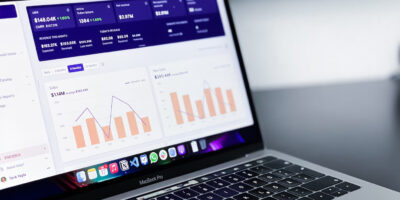
(Source – Pexels)
AI and data analytics may not be as complicated as it seems
Artificial Intelligence (AI) is built on data. Yet, many organizations are still finding it hard to implement AI properly to make the most out of their data. There are concerns that the AI is not able to comprehend the data the way they want it to, especially with more businesses having their data stored across the multi-cloud and even on-premise.
When it comes to data analytics, SAS has been a household vendor in the industry for years. The data analytics leader continues to pioneer new innovations when it comes to providing businesses with the insights they need in the best way possible.
At the same time, with data growing exponentially, businesses want to do a lot more with their data, especially with AI enabling them to do so. But how can businesses be sure of using AI responsibly with their data?
To understand more about SAS and how they are reinventing analytics with AI, Tech Wire Asia speaks to Bryan Harris, Executive Vice President, and Chief Technology Officer at SAS.
Can you share the state of data analytics businesses are going through at this point?
We’re seeing two scenarios emerge now. Some companies are going all out in their analytics spending while others are taking a conservative approach. For the ones that are spending, they realize it’s the new normal and has to navigate it. They use analytics, machine learning, and AI to overcome their information overload. These companies are operating from a position of strength and are looking to double down their investments because they are going to come out stronger when there are disruptions.
We are hoping to educate the businesses that are feeling conservative in their approach to analytics. If they are feeling conservative in their approach now, that’s probably not a good position to be in. Yes, you need to vet finances but you also need to make sure you keep evolving your proficiency in analytics, machine learning, and AI.

Bryan Harris, Executive Vice President, and Chief Technology Officer at SAS.
Why are some businesses still taking a conservative approach toward data analytics and AI?
Apart from cost and regulatory concerns, I think there are the skill set challenges too. To invest in this, you need to make sure there’s a skill set that needs to be brought into the organization. There are still companies that have not made the efforts they needed on getting data management straight. They don’t feel like they have got some rigor to their data, dealing with data, getting it consolidated, or getting to integrate it into a process or a pipeline of getting organization needs to be constantly processing data at all times.
That means you will have repeatable processes and repeatable infrastructure. And then from there, you can start to build these higher-value analytics, and machine learning AI capabilities against that. It’s hard to do that with bad data. In fact, you cannot do any AI effectively with bad data. No math can overcome bad data.
How do you define bad data?
There are probably a couple of dimensions here. One is, if you look at a per data set, it’s the quality of the data itself in the sense that, do all the columns have the data normalized as clean. This includes basic things like states or country names. Do I have a standard representation of the country names? Do I have standards for currency? All the things that you would add formatting of numbers are just basic hygiene of data.
But then you got to look across data and say, have I normalized my data and cleaned my data consistently so that I can connect the data? Can I process the data fast enough? So if I’ve got terabytes of data coming at me every day, can I do these strategies in ways that allow me to keep up with the data? So all of those kinds of capabilities need to be there at the foundation when you start going up the stack and getting into running effective BI reports and analytics against those.
There are still privacy concerns among many when it comes to using AI on data. How can this be dealt with?
I think in general, any PII information needs to be handled with care because the problem with data is that it has a life of its own once it gets out. It gets made up. We know that there are data brokers out there that sell data and if that data is not accurate and people who resell data, it is very terrible because the consumer has to deal with fixing and cleaning that up.
So that’s why we talk about responsible innovation. People need to care because this technology scales to the point the consumers don’t understand how it all happens behind the scenes. They’re just dealing with the consequences of machine learning and AI. Consumers need to be extremely careful, regardless of the regulations. Hopefully, the regulations are strong enough.
People need to think through privacy concerns. They need to think through data-sharing policies, and what they should be. We need to make sure that customers understand how is their data being used.
That’s why there is a backlash on all these social media companies right now. They’re just the product is the customer’s data. I believe that customers want a relationship with a business on data. As long as you provide them with the value of that data that you want, they’re willing to share more with you.
Hence, this relationship with data needs to be more transparent between the company, the business we’re interacting with, and then the consumer of that.
How can you show consumers that you are transparent with their data?
We have something that technology we built up called Model Scorecards. But I think you’re right, it’s harder to be transparent with consumers. However, to the regulators, we provide audits of how we make a decision and report so that we can defend the decisions that are being made for a customer.
I think for consumers, companies need to kind of talk about how they’re making decisions. This includes where AI is involved in a decision, because if consumers don’t know where it is, or where decisions are being made about them, then the business has no way to even fight or contest the decision that consumers don’t disagree with. So I think companies will have to be transparent about how they’re applying AI to customer decisions.
So how does SAS Viya fit into this?
The challenge right now is the pace of change is overwhelming organizations. We’ve been for decades relentlessly pursuing the analytics lifecycle. We want to enable businesses to get insights quickly, discover the data, connect the data and improve the data. From there, they can improve the data, write and develop models to help decision-making, and deploy in production.
People will talk about various parts of the entire process. But we’ve been doing it so much longer that we understand how to effectively do that. It’s about how fast can we help a customer get through their data and also broaden the access to more people in the organization.
If I can enable a coder to collaborate with business analysts, and all of sudden, many business models, and many coders all collaborate on a single platform to go and improve the decision making the organization. That’s an amazing power that empowers the capability of customers to navigate disruptions that we’re seeing in the market today. That’s what we focus on.
We’ve been on the cloud now for several years. With SAS Viya, we’ve added Azure, AWS, and GCP. Recently, we just enabled customers to launch it out of the marketplace. Previously, customers would install it in their tenant, on which cloud they want. Now, it is just a hit with a single click and you’re launching SAS Viya on Microsoft, Azure, and you’re up and running and getting value.
In APAC, we got major banks that are all moving towards SAS Viya for our latest version. We have SAS Viya as our core platform, and we’re building on top of solutions on that. This includes solutions for risk, fraud, REITs, intelligent planning for retail, health, and life sciences for like clinical trials and such.
All of these capabilities are being now seen as a domain solution on top of the core platform. And we’re seeing great adoption. In fact, our growth rate this year from SAS Viya is going to be very good.
Lastly, what is the future of analytics and AI looking like?
For me, it’s all about simulation. For example, big monsoons and weather events are coming. When you see these events, you typically see weather forecasts and like 10 possible paths. Well, I firmly believe that C-level executives and boards want to have that same forecast for the business.
Think of all the disruptions we’re talking about. I want to be able to digitize my business, and then change different input variables to the business and run simulations and look at the likely paths that are going to happen based on the disruptions.
Simply put, through statistics and analytics, I can see what are probably the highest prioritized disruptions over the next three years or a year. From there, I can start to run simulations of those disruptions to my business and can get an understanding of the possible secondary effects on the business. I can now plan for those.
And it’s already starting in the manufacturing industry because the problem is so focused is very discrete. We have a whole partnership with a company called Cosmo Tech, where we’re working with them to do this. We’re simulating the supply chain, modeling the supply chain, and simulating it. And we’re integrating our forecasting and optimization analytics to understand what happens with the supply chain with a demand forecast.
READ MORE
- 3 Steps to Successfully Automate Copilot for Microsoft 365 Implementation
- Trustworthy AI – the Promise of Enterprise-Friendly Generative Machine Learning with Dell and NVIDIA
- Strategies for Democratizing GenAI
- The criticality of endpoint management in cybersecurity and operations
- Ethical AI: The renewed importance of safeguarding data and customer privacy in Generative AI applications


